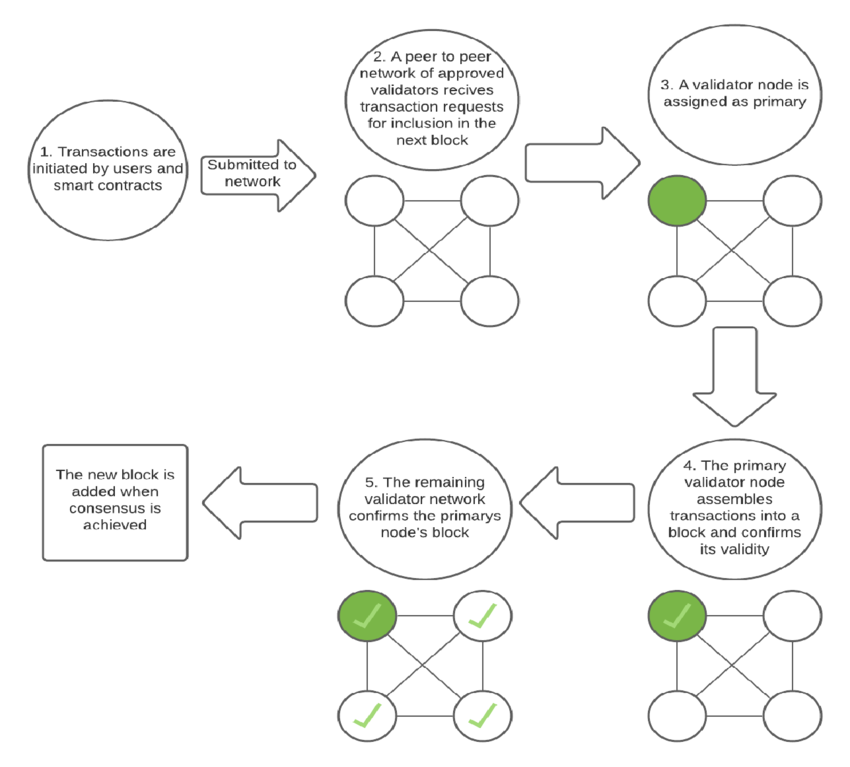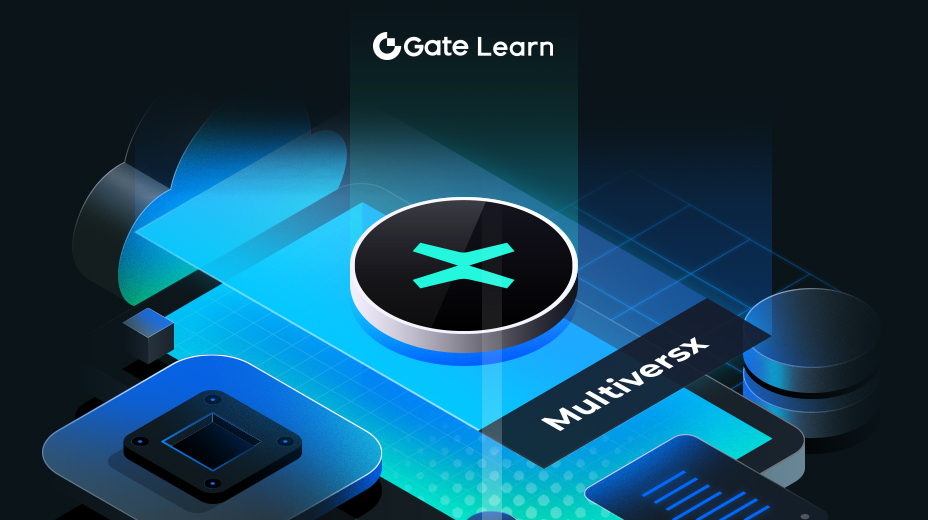Architecture technique de Bitrock
Ce module couvre l'architecture technique de Bitrock, en mettant l'accent sur le mécanisme de consensus IBFT 2.0 Proof of Authority (PoA), les métriques de scalabilité et son interaction avec la machine virtuelle Ethereum (EVM) pour le déploiement de contrats intelligents.
Le mécanisme de consensus Proof of Authority (PoA) IBFT 2.0 expliqué

Le mécanisme IBFT 2.0 PoA équilibre la vitesse, la sécurité et la scalabilité en s'appuyant sur des validateurs de confiance et en garantissant la finalité des blocs grâce au consensus d'une super-majorité. Cela le rend particulièrement adapté aux cas d'utilisation nécessitant un débit élevé et des temps de confirmation rapides, tels que la finance décentralisée (DeFi) et d'autres applications à forte demande.
Le IBFT 2.0 Preuve d'Autorité (PoA)Le mécanisme de consensus utilisé par Bitrock est conçu pour fournir une méthode de validation des transactions plus efficace, évolutive et sécurisée par rapport aux systèmes traditionnels de preuve de travail (PoW) ou de preuve d'enjeu (PoS).
Comment fonctionne IBFT 2.0 PoA :
- ValidateursDans un système de PoA, un groupe prédéfini de validateurs est responsable de vérifier les transactions et d'ajouter de nouveaux blocs à la blockchain. Ces validateurs sont choisis en fonction de leur réputation ou de leur identité, et ils ne concourent pas pour la validation des blocs comme dans les systèmes PoW ou PoS ; au lieu de cela, ils se relaient pour proposer des blocs, réduisant ainsi de manière significative le temps et la puissance de calcul nécessaires.
- Proposition de bloc: Chaque validateur du réseau propose à tour de rôle un bloc. Lorsqu'un validateur propose un bloc, il doit être signé et approuvé par une super-majorité des autres validateurs. En général, au moins 66% des validateurs doivent être d'accord sur la validité du bloc avant qu'il ne soit ajouté à la blockchain.
- Tolérance aux pannes: IBFT 2.0 introduit la tolérance aux fautes byzantines (BFT), ce qui signifie que le réseau peut tolérer qu'un tiers de ses validateurs agissent de manière malveillante ou échouent sans affecter la fonctionnalité du système. Même si certains validateurs sont compromis, le réseau peut continuer à fonctionner en toute sécurité tant qu'une majorité de validateurs sont dignes de confiance.
- EfficacitéÉtant donné que les producteurs de blocs (validateurs) sont pré-approuvés, PoA est beaucoup plus efficace en termes d'utilisation de l'énergie et de vitesse par rapport à PoW, qui nécessite des ressources informatiques étendues. Le mécanisme IBFT 2.0 garantit que les blocs sont finalisés rapidement, permettant des temps de bloc très courts (dans le cas de Bitrock, 1 seconde).
- Sécurité et finalitéUne fois qu'un bloc est validé par le nombre requis de validateurs, il est considéré comme définitif et ne peut être modifié ou annulé. Cette finalité garantit un niveau élevé de sécurité et empêche les attaques potentielles telles que les réorganisations de chaînes.
- Incitations pour les validateursDans la mise en œuvre de Bitrock, les validateurs sont récompensés pour leur rôle dans la sécurisation du réseau en recevant des frais de transaction (en jetons BROCK). Ces récompenses les incitent à maintenir un comportement honnête, car leur identité et leur réputation sont en jeu s'ils agissent de manière malveillante.
Métriques de scalabilité : 12 000 TPS et des temps de blocs de 1 seconde
L'une des caractéristiques déterminantes de Bitrock est sa scalabilité. Le réseau est conçu pour gérer jusqu'à 12 000 transactions par seconde (TPS), dépassant largement le débit de transaction du mainnet d'Ethereum, qui avoisine 15 TPS en moyenne. Cette scalabilité rend Bitrock adapté aux applications décentralisées à forte demande, notamment dans des secteurs tels que le jeu et la finance décentralisée (DeFi).
Le réseau atteint également un temps de bloc de 1 seconde impressionnant, qui est le temps nécessaire pour ajouter un nouveau bloc à la blockchain. Cette génération rapide de blocs garantit que les transactions sont confirmées presque instantanément, améliorant considérablement l'expérience utilisateur. Ces caractéristiques placent Bitrock parmi les solutions Layer-2 les plus avancées en termes de vitesse et de scalabilité, notamment par rapport à d'autres chaînes Layer-2 comme Polygon et Arbitrum, qui offrent une throughput inférieure et des temps de bloc plus longs.
Comparaison du PoA avec les systèmes traditionnels de preuve de travail (PoW) et de preuve d'enjeu (PoS)
Le mécanisme de consensus PoA utilisé par Bitrock diffère fondamentalement des systèmes plus largement utilisés de Preuve de Travail (PoW) et de Preuve d'Enjeu (PoS) :
- Preuve de travail (PoW)Dans un système PoW, comme celui de Bitcoin, les mineurs rivalisent pour résoudre des énigmes mathématiques complexes afin de valider les transactions. Ce processus nécessite une puissance de calcul et une énergie considérables. Les systèmes PoW sont connus pour leur sécurité élevée mais souffrent de vitesses de transaction lentes et d'une consommation énergétique élevée, ce qui les rend moins évolutifs pour les applications nécessitant un débit élevé.
- Preuve d'enjeu (PoS): Dans les systèmes PoS, tels que Ethereum 2.0, les validateurs sont choisis en fonction du nombre de jetons qu'ils bloquent. Bien que le PoS consomme beaucoup moins d'énergie que le PoW, il peut encore être plus lent que le PoA, car les validateurs doivent bloquer des jetons pour avoir une chance de proposer des blocs, ce qui peut entraîner des retards en fonction de la congestion du réseau et de la concurrence en matière de blocage.
- Preuve d'autorité (PoA): PoA, en revanche, repose sur un ensemble de validateurs présélectionnés qui n'ont pas besoin de se battre pour la validation des blocs. Au lieu de cela, ils se relaient pour ajouter des blocs à la blockchain de manière prédéterminée. Ce processus élimine le besoin de grandes quantités de puissance de calcul (comme dans PoW) ou d'actifs mis en jeu (comme dans PoS), ce qui rend PoA beaucoup plus efficace en termes de vitesse et d'utilisation de l'énergie. Le compromis avec PoA est qu'il nécessite de faire confiance aux validateurs, c'est pourquoi Bitrock met l'accent sur son utilisation de validateurs de confiance et vérifiés grâce à des processus KYC comme ceux proposés par Assure DeFi.

Temps de bloc de 1 seconde et débit de transactions de 12 000 TPS
Les temps de bloc rapides de Bitrock et le débit élevé des transactions sont atteints grâce à la combinaison du mécanisme de consensus IBFT 2.0 PoA et de l'infrastructure réseau optimisée. Les validateurs du réseau sont pré-approuvés et tournent efficacement pour garantir que les blocs sont validés et ajoutés rapidement sans retard inutile. La conception tolérante aux pannes de l'IBFT 2.0 permet une disponibilité élevée, garantissant que même si certains validateurs échouent, le réseau continue de fonctionner en douceur.
Parce que Bitrock fonctionne comme une solution de couche 2 compatible avec Ethereum, il traite les transactions hors chaîne puis les règle sur la chaîne principale d'Ethereum. Ce traitement hors chaîne permet à Bitrock de contourner la congestion qui peut se produire sur la couche 1 d'Ethereum, contribuant ainsi à sa capacité à gérer un volume de transactions significativement plus élevé tout en maintenant des frais de gaz proches de zéro.
Interaction avec la Machine Virtuelle Ethereum (EVM) pour le déploiement de Smart Contract
Bitrock est entièrement compatible avec la machine virtuelle Ethereum (EVM), ce qui signifie que les développeurs peuvent déployer des contrats intelligents sur Bitrock en utilisant les mêmes outils qu'ils utiliseraient pour Ethereum. Cela inclut des environnements de développement populaires tels que Metamask, Truffle et Remix. En maintenant la compatibilité avec Ethereum, Bitrock permet aux développeurs de transférer leurs applications et projets basés sur Ethereum vers Bitrock sans avoir à modifier leur code de manière significative.
Points forts
- Bitrock utilise le mécanisme de consensus IBFT 2.0 Proof of Authority, qui repose sur des validateurs de confiance pour la validation des blocs.
- Le réseau peut traiter jusqu'à 12 000 transactions par seconde, avec des temps de bloc d'1 seconde, le rendant très évolutif.
- Le PoA est plus économe en énergie et plus rapide que les systèmes traditionnels PoW ou PoS, bien qu'il nécessite une confiance envers les validateurs.
- L'architecture de Bitrock garantit un débit de transactions élevé et une faible latence en déchargeant les transactions vers sa solution de couche 2.
- La compatibilité totale de la Machine Virtuelle Ethereum (EVM) permet aux développeurs de déployer des contrats intelligents à l'aide des outils Ethereum existants.





